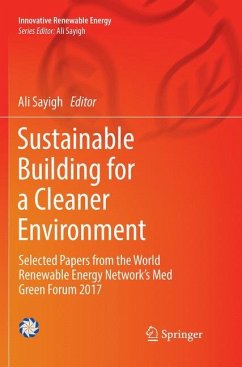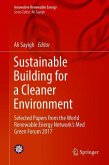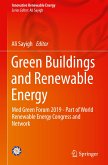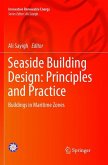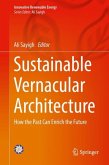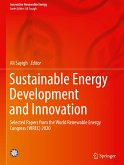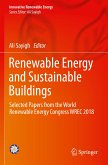Sustainable Building for a Cleaner Environment
Selected Papers from the World Renewable Energy Network's Med Green Forum 2017
Herausgegeben:Sayigh, Ali
Sustainable Building for a Cleaner Environment
Selected Papers from the World Renewable Energy Network's Med Green Forum 2017
Herausgegeben:Sayigh, Ali
- Broschiertes Buch
- Merkliste
- Auf die Merkliste
- Bewerten Bewerten
- Teilen
- Produkt teilen
- Produkterinnerung
- Produkterinnerung
This book contains selected papers presented during the bi-annual World Renewable Energy Network's Med Green Forum aimed at the international community as well as Mediterranean countries. This forum highlights the importance of growing renewable energy applications in two main sectors: Electricity Generation and the Sustainable Building Sector. In-depth chapters highlight the most current research and technological breakthroughs, covering a broad range of renewable energy technologies and applications in all sectors - for electricity production, heating and cooling, agricultural applications,…mehr
Andere Kunden interessierten sich auch für
![Sustainable Building for a Cleaner Environment Sustainable Building for a Cleaner Environment]() Sustainable Building for a Cleaner Environment81,99 €
Sustainable Building for a Cleaner Environment81,99 €![Green Buildings and Renewable Energy Green Buildings and Renewable Energy]() Green Buildings and Renewable Energy122,99 €
Green Buildings and Renewable Energy122,99 €![Green Buildings and Renewable Energy Green Buildings and Renewable Energy]() Green Buildings and Renewable Energy121,99 €
Green Buildings and Renewable Energy121,99 €![Seaside Building Design: Principles and Practice Seaside Building Design: Principles and Practice]() Seaside Building Design: Principles and Practice69,99 €
Seaside Building Design: Principles and Practice69,99 €![Sustainable Vernacular Architecture Sustainable Vernacular Architecture]() Sustainable Vernacular Architecture145,99 €
Sustainable Vernacular Architecture145,99 €![Sustainable Energy Development and Innovation Sustainable Energy Development and Innovation]() Sustainable Energy Development and Innovation133,99 €
Sustainable Energy Development and Innovation133,99 €![Renewable Energy and Sustainable Buildings Renewable Energy and Sustainable Buildings]() Renewable Energy and Sustainable Buildings89,99 €
Renewable Energy and Sustainable Buildings89,99 €-
-
-
This book contains selected papers presented during the bi-annual World Renewable Energy Network's Med Green Forum aimed at the international community as well as Mediterranean countries. This forum highlights the importance of growing renewable energy applications in two main sectors: Electricity Generation and the Sustainable Building Sector. In-depth chapters highlight the most current research and technological breakthroughs, covering a broad range of renewable energy technologies and applications in all sectors - for electricity production, heating and cooling, agricultural applications, water desalination, industrial applications and for the transport sectors.
Produktdetails
- Produktdetails
- Innovative Renewable Energy
- Verlag: Springer / Springer International Publishing / Springer, Berlin
- Artikelnr. des Verlages: 978-3-030-06881-3
- Softcover reprint of the original 1st edition 2019
- Seitenzahl: 484
- Erscheinungstermin: 21. Dezember 2018
- Englisch
- Abmessung: 235mm x 155mm x 27mm
- Gewicht: 735g
- ISBN-13: 9783030068813
- ISBN-10: 3030068811
- Artikelnr.: 57018144
- Herstellerkennzeichnung Die Herstellerinformationen sind derzeit nicht verfügbar.
- Innovative Renewable Energy
- Verlag: Springer / Springer International Publishing / Springer, Berlin
- Artikelnr. des Verlages: 978-3-030-06881-3
- Softcover reprint of the original 1st edition 2019
- Seitenzahl: 484
- Erscheinungstermin: 21. Dezember 2018
- Englisch
- Abmessung: 235mm x 155mm x 27mm
- Gewicht: 735g
- ISBN-13: 9783030068813
- ISBN-10: 3030068811
- Artikelnr.: 57018144
- Herstellerkennzeichnung Die Herstellerinformationen sind derzeit nicht verfügbar.
Dr. Ali Sayigh is Chairman and Founder of the World Renewable Energy Congress and Council; Director General of World Renewable Energy Network (WREN); Chairman and Founder of the Arab Solar Energy Society; and Past Chairman of the UK Solar Energy Society. Dr. Sayigh was recently elected to chair the Iraqi Energy Institute, and he actively consults on renewable and sustainable energy issues for a number of international organizations, including UNESCO, ISESCO, UNDP, ESCWA, & UNIDO. Dr. Sayigh was Director of Solar Seminars at ICTP Trieste, Italy from 1977-1995; Professor of Solar Energy at King Saud, Kuwait, and Reading Universities from 1969 to 1994, and Professor of Engineering at the University of Hertfordshire from 1994 to 2004. He was the founding expert in Renewable Energy at AOPEC. He is Fellow of the Institute of Energy; Fellow of the Institution of Electrical Engineers; and Chartered Engineer. He has published more than 400 papers and has contributed to and edited more than 40 books. He has been Editor and Editor in Chief of several international journals including Renewable Energy, renewable energy and environmental sustainability and the International Journal of Environmental Sciences and Technology and Editor-in-Chief of the Major Reference Work, Comprehensive Renewable Energy. Winner of the best organization promoting renewable energy in UK for 2018
Chapter 1. Proposing a new method for fenestration shading design in prefabricated modular buildings.- Chapter 2.Effectiveness of occupant behavioral ventilation strategies on indoor thermal comfort in hot-arid climate.- Chapter 3.Effectiveness of materials, technologies and renewable energy in educational buildings through cluster analysis of energy retrofitting.- Chapter 4.Renewable Energy in Argentina.- Chapter 5.Wind energy potential research in a low building within an urban environment.- Chapter 6.The natural light in Architecture. The use inspired by the constructive tradition.- Chapter 7.The cost of building to the near Zero Energy Building standard - a financial case study.- Chapter 8.Policy of intensification, diversification, conservation, and indexation in pursuing the sustainable transport.- Chapter 9.Problem of education in developing renewable of energy.- Chapter 10.Winter performance of certified passive houses In a Temperate Maritime Climate - nZEB Compliant?.- Chapter11.A parametric tool for assessing optimal location of buildings according to environmental Criteria.- Chapter 12.Methodology of Solar Project Managing Through All Stages of Development.- Chapter 13.Computational BIPV Design: An energy optimization tool for solar facades.- Chapter 14.Feasibility Study of a Low Carbon House in the UK.- Chapter 15.Why Do We Need To Reduce The Carbon Footprint In UAE?.- Chapter 16.Urban farming in the era of crisis in greece: the case study of the urban garden of Agioi Anargiroi -Kamatero and Fili.- Chapter 17.Resilient urban design- Beograd and Florence: Reconnect the waters to the city.- Chapter 18.Strategic Sustainable and Smart Development Based on User Behavior.- chapter 19.High Bombastic adaptive skin conceptual prototype for mediterranean climate.- Chapter 20. Quality of healthcare: a review of the impact of hospital physical environment on improving quality of care.- Chapter 21. Enhancing Indoor Air Quality for Residential Building in Hot Arid Regions.- Chapter 22.Performance of Solar Window Film With Reference to Energy Rationalizing in Buildings.- Chapter 23.Visualizing the infrared response of an urban canyon throughout a sunny day.- chapter 24.Meta-design approach to Environmental building programming for passive cooling of Buildings.- Chapter 25.Urban and Architectural Sustainability in Restoration of Iranian cities (Strategy and Challenges), Case study of Soltaniyeh.- Chapter 26.-Influence of the pariod of measurements on wind potential assessment for a given site.- Chapter 27.Integration strategies of Luminescent Solar Concentrators panels: a case study in Florence - Italy.- Chapter 28.Photovoltaic and Thermal solar concentrator integrated into a dynamic shading device.- Chapter 29.A University Master Course and training program for energy managers and expert in environmental design in Italy.- Chapter 30.A project for the NZERO-Foundation in the south of Italy.- Chapter 31.Planning without waste.- Chapter 32. Problem OfEducation In Developing Renewable Of Energy.- Chapter 33.Problem Of Education In Developing Renewable Of Energy.- Chapter 34. Resilient urban design. beograd and florence: reconnect the waters to the city.- Chapter 35.Evaluating deep retrofit strategies for buildings in urban waterfronts.- Chapter 36.Enhancing the Thermo-physical Properties of Rammed Earth by Stabilizing with Corn Husk Ash.- Chapter 37.Thermal monitoring of low income housings built with autoclaved aerated concrete in a hot-dry climate.- Chapter 38.Renewables are commercially justified to save fuel and not for storage.- Chapter 39.Climate Change Assessment, Simulation and Adaptation for Hot-Arid Urban Settlements: The Case Study of Asmara Project, Cairo, Egypt.- Chapter 40.Climate Change Assessment, Simulation and Adaptation for Hot-Arid Urban Settlements: The Case Study of Asmara Project, Cairo, Egypt.- Chapter 41.Ventilation effectiveness of residential ventilation systems and its energy saving potential.- Chapter 42.Assessment of cardboard as an environment-friendly wall thermal insulation for low energy prefabricated buildings.
Chapter 1. Proposing a new method for fenestration shading design in prefabricated modular buildings.- Chapter 2.Effectiveness of occupant behavioral ventilation strategies on indoor thermal comfort in hot-arid climate.- Chapter 3.Effectiveness of materials, technologies and renewable energy in educational buildings through cluster analysis of energy retrofitting.- Chapter 4.Renewable Energy in Argentina.- Chapter 5.Wind energy potential research in a low building within an urban environment.- Chapter 6.The natural light in Architecture. The use inspired by the constructive tradition.- Chapter 7.The cost of building to the near Zero Energy Building standard - a financial case study.- Chapter 8.Policy of intensification, diversification, conservation, and indexation in pursuing the sustainable transport.- Chapter 9.Problem of education in developing renewable of energy.- Chapter 10.Winter performance of certified passive houses In a Temperate Maritime Climate - nZEB Compliant?.- Chapter11.A parametric tool for assessing optimal location of buildings according to environmental Criteria.- Chapter 12.Methodology of Solar Project Managing Through All Stages of Development.- Chapter 13.Computational BIPV Design: An energy optimization tool for solar facades.- Chapter 14.Feasibility Study of a Low Carbon House in the UK.- Chapter 15.Why Do We Need To Reduce The Carbon Footprint In UAE?.- Chapter 16.Urban farming in the era of crisis in greece: the case study of the urban garden of Agioi Anargiroi -Kamatero and Fili.- Chapter 17.Resilient urban design- Beograd and Florence: Reconnect the waters to the city.- Chapter 18.Strategic Sustainable and Smart Development Based on User Behavior.- chapter 19.High Bombastic adaptive skin conceptual prototype for mediterranean climate.- Chapter 20. Quality of healthcare: a review of the impact of hospital physical environment on improving quality of care.- Chapter 21. Enhancing Indoor Air Quality for Residential Building in Hot Arid Regions.- Chapter 22.Performance of Solar Window Film With Reference to Energy Rationalizing in Buildings.- Chapter 23.Visualizing the infrared response of an urban canyon throughout a sunny day.- chapter 24.Meta-design approach to Environmental building programming for passive cooling of Buildings.- Chapter 25.Urban and Architectural Sustainability in Restoration of Iranian cities (Strategy and Challenges), Case study of Soltaniyeh.- Chapter 26.-Influence of the pariod of measurements on wind potential assessment for a given site.- Chapter 27.Integration strategies of Luminescent Solar Concentrators panels: a case study in Florence - Italy.- Chapter 28.Photovoltaic and Thermal solar concentrator integrated into a dynamic shading device.- Chapter 29.A University Master Course and training program for energy managers and expert in environmental design in Italy.- Chapter 30.A project for the NZERO-Foundation in the south of Italy.- Chapter 31.Planning without waste.- Chapter 32. Problem OfEducation In Developing Renewable Of Energy.- Chapter 33.Problem Of Education In Developing Renewable Of Energy.- Chapter 34. Resilient urban design. beograd and florence: reconnect the waters to the city.- Chapter 35.Evaluating deep retrofit strategies for buildings in urban waterfronts.- Chapter 36.Enhancing the Thermo-physical Properties of Rammed Earth by Stabilizing with Corn Husk Ash.- Chapter 37.Thermal monitoring of low income housings built with autoclaved aerated concrete in a hot-dry climate.- Chapter 38.Renewables are commercially justified to save fuel and not for storage.- Chapter 39.Climate Change Assessment, Simulation and Adaptation for Hot-Arid Urban Settlements: The Case Study of Asmara Project, Cairo, Egypt.- Chapter 40.Climate Change Assessment, Simulation and Adaptation for Hot-Arid Urban Settlements: The Case Study of Asmara Project, Cairo, Egypt.- Chapter 41.Ventilation effectiveness of residential ventilation systems and its energy saving potential.- Chapter 42.Assessment of cardboard as an environment-friendly wall thermal insulation for low energy prefabricated buildings.

